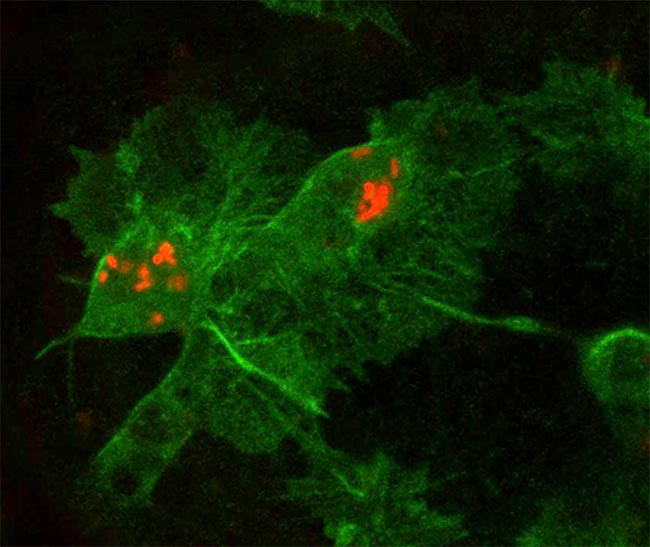Caught on Video: Immune Cell Destroys Bacteria

In a starring role for E. coli, researchers have developed a new technique to make movies of bacteria as they infect their victims and are consumed by the host's immune cells.
The movies mark the first time that scientists have been able to look at bacteria infecting living organisms in real time, according to the researchers. Most studies of bacterial infections are preformed after the host has died. The scientists, from the University of Bath and the University of Exeter in the UK, tested out their movie-making method on developing fruit fly embryos. They injected fluorescently tagged bacteria into the embryos and observed how the microbes interacted with the insect's immune cells, called hemocytes, using time-lapse confocal microscopy, an imaging technique. They used two types of bacteria for the study Escherichia coli and Photorhabdus asymbiotica. In one of the videos, an immune cell recognizes and engulfs a bacterium.
{{ video="LS_090730_InVivoVideo" title="Watch the Attack" caption="For the first time, medical researchers make movies inside a living animal of attack by immune cells on bacteria. Hemocytes (green) rapidly engulf E.coli (red) in this time-lapse microscope movie. Credit: Isabella Vlisidou / Dave Brody" }} "Cells often behave very differently once they have been taken out of their natural environment and cultured in a petri dish," Will Wood, a researcher at the University of Bath, said in a statement. "Therefore it is really important to study whole organisms to fully understand how bacteria interact with their host." The researchers can also monitor the movement of bacterial proteins with tags and see how individual proteins take part in the infection process. In the future, they hope to use this technique with microbes that cause disease in humans, such as Listeria and Trypanosomes. Watching how these bacteria interact with the immune system in real-time may lead to a better understanding of how they cause infection, and could eventually give rise to improved antibacterial treatments. "To be able to film the microscopic battle between single bacterial cells and immune cells in a whole animal and in real time is astounding." Nick Waterfield, co-author on the study and Research Officer at the University of Bath, said in a statement. "It will ultimately allow us to properly understand the dynamic nature of the infection process." The results were published in the journal Public Library of Science Pathogens on July 17. The research was funded by the Wellcome Trust and the Biotechnology & Biological Sciences Research Council.
- Video: Watch the Immune Cells Munch Bacteria
- War on Bacteria Is Wrongheaded
- All About Bacteria
Sign up for the Live Science daily newsletter now
Get the world’s most fascinating discoveries delivered straight to your inbox.

Rachael is a Live Science contributor, and was a former channel editor and senior writer for Live Science between 2010 and 2022. She has a master's degree in journalism from New York University's Science, Health and Environmental Reporting Program. She also holds a B.S. in molecular biology and an M.S. in biology from the University of California, San Diego. Her work has appeared in Scienceline, The Washington Post and Scientific American.










